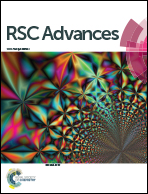Investigation of proton-driven amine functionalized tube array as ion responsive biomimetic nanochannels†
Abstract
A simple amine embellished tube array was assembled at the liquid–liquid interface to study ion transfer behavior. Variation in the pH of the solution resulted in three different protonation states at the amino groups of the nanochannel, which in turn regulated ion transport, similar to the switching effect of ion channels in vivo.


 Please wait while we load your content...
Please wait while we load your content...